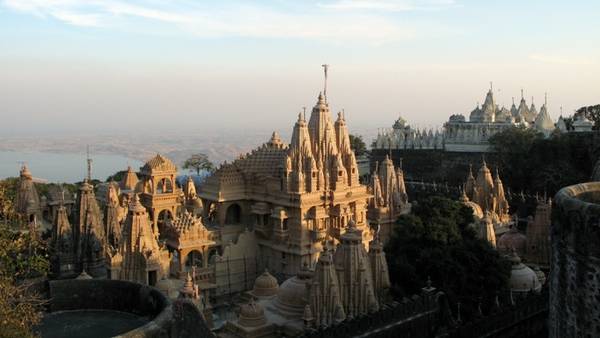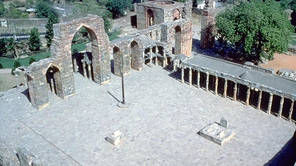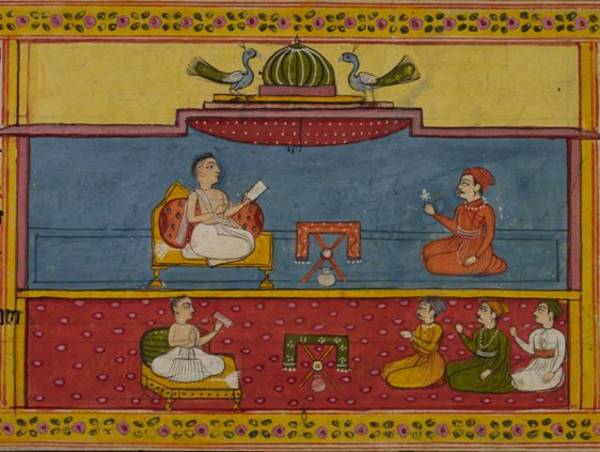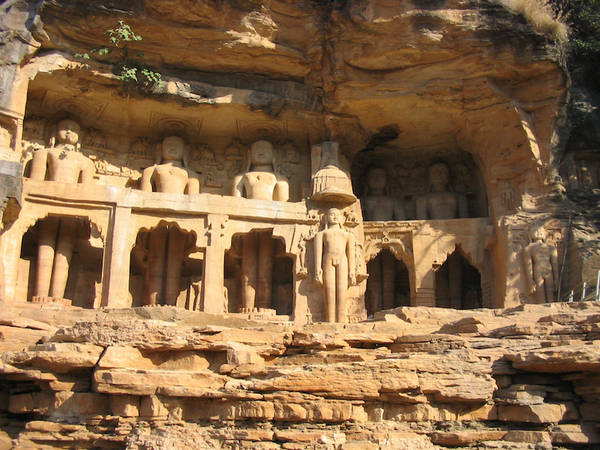Article: Jains and the Delhi Sultanate
The three centuries of the Delhi Sultanate witnessed the growth of varied encounters between Jains and their political rulers.
The Delhi Sultanate was a succession of short-lived Islamicate dynasties that ruled from Delhi beginning in 1206, controlling varying portions of north India. Many of these sultans or kings were of Central Asian descent and spoke Persian. The last of the Delhi Sultanates was overthrown by the Mughal Empire in 1526.
At times the Delhi Sultanate used temple destruction against Jain communities as a way of establishing political power. But overall the two communities experienced largely good relations. Śvetāmbara mendicants visited the royal court and gained decrees that advanced Jain interests, such as tax concessions for pilgrimage centres. Trade connections between the two groups blossomed, and Jain traders were even known to sponsor the construction of mosques for their Muslim business partners.
Temple attacks and reuse
The early Delhi Sultanate rulers occasionally engaged in temple destruction, which had been a political strategy of both Islamic and Hindu kings in India for centuries. Śvetāmbara and Digambara communities alike experienced raids. For example, the key Gujarati pilgrimage site of Shatrunjaya suffered desecration in 1313. In the 15th century, a bhaṭṭāraka in Rajasthan distributed a thousand images across the subcontinent to replace those harmed by Islamic attacks. Jains often viewed these incidents as part of the degradation of the age rather than as religious conflicts.
The sultanates also used parts of ruined Jain temples in their own building projects, such as the Quwwat al-Islam mosque near the Qutb Minar. However, the extent and meaning of such reuse remains heavily debated today.
Trade and politics

Mount Shatrunjaya temples
Image by Amre Ghiba © CC BY-NC 2.0
Despite occasional temple damage, Jains and Muslims generally associated on friendly terms during Delhi Sultanate rule. Strong trading relationships developed between members of the two communities, particularly in Gujarat. These business connections also extended to cultural and political favours.
In the 13th century, Jain merchants already enjoyed good relations with Muslims. For instance, Jagaḍū was a 13th-century merchant from Kachchh, Gujarat, who frequently did business with Muslims. Many details of his life are recorded in the 14th-century Sanskrit biography by Sarvānanda, entitled Jagaḍū-carita – Acts of Jagaḍū. Jagaḍū’s work occasionally raised ethical issues, such as when he profited from animal products that involved violence against living beings. One of the key Jain values is non-violence. Nonetheless Jagaḍū and other Jain merchants forged successful commercial connections with Muslims. They even subsidised the building of mosques in Gujarat for their trading partners.
The Islamic presence increased in western India after Alauddin Khalji’s generals raided Somanatha in Gujarat in 1299. The next few decades witnessed the spread of Sultanate rule in Gujarat, which prompted Jains and Muslims to interact more frequently and amicably. In one instance, Khalji soldiers aroused local resentment by damaging some Jain temples at the pilgrimage site of Shatrunjaya in 1313. Good relations were restored when a Patan merchant and the local Khalji governor jointly financed the temples’ repairs.
Jain traders flourished during Khalji rule both in Gujarat and Delhi. Thakkar Pheru may have been the first Jain to gain a prestigious position at the royal court in Delhi, where he was charged with caring for precious stones and minting coins in the Khalji treasury. Thakkar Pheru also served in this position under Ghiyasuddin Tughlaq.
Monks at the Tuqhlaq court
During the 14th century, a monk from the Kharatara-gaccha sect named Jinaprabha-sūri visited the Islamicate court in Delhi. There he met the sultan, Muhammad bin Tughlaq, several times. Jinaprabha personally described these encounters in his Vividha-tīrtha-kalpa – Guidebook to Various Pilgrimage Places. Jinaprabha converted his imperial influence into royal favours for the Jain community, beginning a pattern continued by Jain monks who gained political support from Mughal rulers.
In their first meeting, Jinaprabha impressed Muhammad bin Tughlaq with his eloquent poetry and sharp debating skills. The Tughlaq ruler rewarded Jinaprabha and his companion, Jinadeva, with many gifts, a lavish ceremony and a formal order granting protection to all Śvetāmbara Jains.
In later meetings, Jinaprabha secured:
- assurances of safety for pilgrimage sites
- the discharge of prisoners
- the return of an image of Mahāvīra held in the sultan’s treasury.
Jinaprabha eventually left the court and headed south. He may have subsequently come across Muhammad bin Tughlaq on the road and accompanied the sultan on a military campaign. A contemporary of Jinaprabha narrates these later events.
Many Jain authors retold Jinaprabha’s experiences at the Tughlaq court, often with creative embellishments. For example, a Prakrit collection of stories called Vṛddhācārya-prabandhāvalī – Accounts of the Eminent Teachers – narrates that Jinaprabha exorcised a demon from Muhammad bin Tughlaq’s wife. An undated prabandha work changes the sultan to Firuz Shah, Muhammad bin Tughlaq’s successor, and claims that Jinaprabha nearly converted the Muslim ruler to the Jain faith.
This same text also questions the appropriateness of ascetics visiting a royal court. Mendicants renounced earthly concerns upon their initiation, and kingly courts were hubs of worldly affairs. This tension was a common issue for Jain monks who had relations with rulers of all religious faiths.
Cultural impacts on Jains
During the Sultanate period, relations with Muslims had notable effects on the Jain cultural sphere. Jains wrote about various features of the Islamicate world and began incorporating aspects of Persianate culture into Sanskrit texts. In addition, Jains responded in material forms to the Islamic practices they encountered.
Jains authored numerous texts that emerged from their exposure to Islamicate traditions. For example, the monk Jinaprabha has been attributed with as many as three works that use Persian extensively. The Śāntināthāṣṭaka remains enigmatic but is described as a ‘Persian-language citrakāvya‘. The other two texts are:
- a one-stanza Persian praise to a Jina accompanied by a commentary
- an 11-verse hymn to Ṛṣabhanātha or Lord Ṛṣabha, the first Jina.
Scholars have fruitfully analysed these works to show that, though written grammatically in Persian, they also conform to Sanskrit metrics. Therefore these two works have a peculiar position as truly cross-cultural projects.
Jains also produced various technical treatises that reflect their ties with Islamic culture. In 1365, Salakṣa crafted the first bilingual Sanskrit–Persian dictionary. Entitled Śabda-vilāsa – Play of Persian – it was sponsored by a regional Rathod ruler in Gujarat. The Jain monk Mahendra-sūri spent time at the court of Firuz Shah Tughlaq and authored the first Sanskrit treatise on astrolabes, called Yantra-rāja – King of Instruments – in 1370. His pupil, Malayendu-sūri, added a commentary to the work in 1382.
Jains were also responsible for some of the earliest historical kāvyas that feature Muslims as major actors. For example, Nayacandra’s Hammīra-mahākāvya – Great Poem on Hammira – written around 1420, describes Alauddin Khalji’s military exploits in Rajasthan. Like many of his contemporaries, Nayacandra presents Islamic military victories as part of the inevitable depravity in the Jain conception of cyclical time.
Beyond texts, scholars have suggested that certain Jain building projects were also responses to Islamic authority. For instance, Digambara Jains carved a series of colossal statues of the Jinas at Gwalior, Madhya Pradesh, in the 15th century. These monumental images may have been designed to survive the end of the world, which was being ushered in by Islamic rule.
Reading
- Absent Lord: Ascetics and Kings in a Jain Ritual Culture
Lawrence A. Babb - Comparative Studies in Religion & Society series; volume 8
University of California Press; Berkeley, California, USA; 1996
- ‘A propos des hymnes jaina multilingues (sanskrit, prakrit, persan)’
Nalini Balbir - Indica et Tibetica: Festschrift für Michael Hahn
edited by Konrad Klaus and Jens-Uwe Hartmann
Wiener Studien zur Tibetologie und Buddhismuskunde series; volume 66
Arbeitskreis für Tibetische und Buddhistische Studien; Vienna, Austria; 2007
- ‘Who Is a King?: Jain Narratives of Kingship in Medieval Western India’
John E. Cort - Open Boundaries: Jain Communities and Cultures in Indian History
edited by John E. Cort
SUNY Series in Hindu Studies series
State University of New York Press; Albany, New York, USA; 1998
- ‘Tales of Broken Limbs and Bleeding Wounds: Responses to Muslim Iconoclasm in Medieval India’
Phyllis Granoff - East and West
volume 41: 1/4
1991
- ‘Mountains of Eternity: Raidhū and the Colossal Jinas of Gwalior’
Phyllis Granoff - Rivista di Studi Sudasiatici
volume 1
Firenze University Press; 2006
- The Clever Adulteress and Other Stories: A Treasury of Jain Literature
Phyllis Granoff - Mosaic Press; Oakville, Ontario, Canada; New York, USA; London, UK; 1990
- ‘The Persian of Jain Hymns’
Banarsi Das Jain - Siddha-Bhāratī, or the Rosary of Indology
edited by Vishva Bandhu
Vishveshvaranand Indological series; volume 1
Vishveshvaranand Vedic Research Institute P. & P. Organization; Hoshiarpur; 1950
- ‘Qutb and Modern Memory’
Sunil Kumar - The Partitions of Memory: The Afterlife of the Division of India
edited by Suvir Kaul
Permanent Black; Delhi, India; 2001
- Building Communities in Gujarāt: Architecture and Society during the Twelfth through Fourteenth Centuries
Alka Patel - Brill's Indological Library series; series editor Johannes Bronkhorst; volume 22
Brill; Leiden, Netherlands; 2004
- ‘Sulṭān, Sūri and the Astrolabe’
S. R. Sarma - Indian Journal of History of Science
volume 35: 2
2000
- ‘Śabda-vilāsa or Pārasīnāmamālā of Mantrī Salakṣa of Gujarat’
Umakant P. Shah - Vimarśa: A Half-Yearly Research Bulletin of Rashtriya Sanskrit Samsthan New Delhi
volume 1: 1
1972
- Forging a Region: Sultans, Traders, and Pilgrims in Gujarat 1200–1500
Samira Sheikh - SOAS Studies on South Asia series; volume 5
Oxford University Press; Delhi, India and Oxford, UK; 2009
- The Many Lives of a Rajput Queen: Heroic Pasts in India c. 1500–1900
Ramya Sreenivasan - University of Washington Press; Seattle, Washington, USA; 2007
- Somanatha: the Many Voices of a History
Romila Thapar - Penguin Books India; New Delhi, India; 2004
- Vividhatīrthakalpaḥ: Regards sur le lieu saint jaina
Jinaprabhasūri - translated by Christine Chojnacki
Publications du département d’indologie series; volume 85
Institut Français de Pondichéry, Ecole Française d'Extrême-Orient; Pondicherry, Puducherry, India; 1995
- Vividhatīrthakalpa
Jinaprabhasūri - edited by Muni Jinavijaya
Singhi Jain series; volume 10
Shantiniketan; Bombay, India; 1934
- Early Medieval India and the Expansion of Islam 7th–11th Centuries
André Wink - Al-Hind: The Making of the Indo-Islamic World series; volume 1
Brill; Boston, Massachusetts, USA and Leiden, Netherlands; 2002
- The Slave Kings and the Islamic Conquest 11th–13th Centuries
André Wink - Al-Hind: The Making of the Indo-Islamic World series; volume 2
Brill; Boston, Massachusetts, USA and Leiden, Netherlands; 2002
Links
- Khalji gold coin
-
The British Museum displays a gold coin minted in 1318 under Sultan Qutb al-Din Mubarak Shah I, final ruler of the Khalji dynasty. Thakkaur Pheru was master of the mint for three sultans of Delhi, and may have been the first Jain to gain a prestigious position at the imperial court.
https://www.britishmuseum.org/collection/object/C_1911-0709-2053
- Jina statues at Gwalior
-
Flickr provides pictures of the mutilated Digambara figures of Jinas in Gwalior, Madhya Pradesh. Taken in 2007, these photographs by Sergio Conti also show some of the later repairs to several of the rock-cut statues. The huge naked images were carved in the 15th century and damaged a century later on the orders of the Emperor Babur, founder of the Mughal dynasty.
http://www.flickr.com/photos/sergioconti/2285506718/in/set-72157603874876112/
- Jina images and temples at Gwalior
-
The pilgrimage centre of Gwalior in central India is famous for its carvings of Jinas. Both freestanding and relief sculptures, the Jinas are found in the temples as well as in panels cut into walls of rock. This collection of drawings and photographs is presented by Professor Frances W. Pritchett of Columbia University in New York.
http://www.columbia.edu/itc/mealac/pritchett/00routesdata/1000_1099/jaintemples/gwalior/gwalior.html
- Views of pilgrimage site of Gwalior
-
Photographs of Gwalior in Madhya Pradesh, including details of interior architecture and the numerous large statues of Jinas for which the site is famous.
Provided by the World Art Treasures, the Fondation Jacques-Edouard Berger in Lausanne, Switzerland.
(Input Gwalior in Madhya Pradesh in Search)
- +
- aAbhavya
- aAbhinandana
- aAbhiṣeka
- aĀcāra
- aĀcārāṅga-sūtra
- aĀcārya
- aAchalbhrata
- aAḍhāī-dvīpa
- aAdharma
- aAdho-loka
- aAdhyayana
- aAdvaita Vedānta
- aĀgama
- aAghātīya
- aAghātīya-karman
- aAgnibhuti
- aAgra
- aĀhāra
- aAhiṃsā
- aAhimsa Day
- aAjita
- aAjīva
- aAkampit
- aĀkāśa
- aAkbar the Great
- aAkṣaya-tṛtīyā
- aAlauddin Khalji
- aAlbert Einstein
- aAllah
- aAlms
- aĀlocanā
- aAloka-ākāśa
- aAmāri
- aAmbikā or Kūṣmāṇḍinī
- aAnagāra
- aAnanta
- aAnarthadaṇḍa
- aAnaśana
- aAnekānta-vāda
- aAṅga
- aAniconism
- aAnojjā
- aAntarāla
- aAntarāya-karma
- aAṇu
- aAṇu-vrata
- aAnukampā
- aAnuprekṣā
- aAnusvāra
- aApabhraṃśa
- aAparigraha
- aAra
- aĀrambha
- aĀrambhaja
- aĀratī
- aArdhamāgadhī Prākrit
- aArhaṃ
- aArhat
- aArśana-āvaraṇīya-karma
- aĀrta-dhyāna
- aĀryikā
- aĀryikā Jñānamati
- aĀśātanā
- aĀścarya
- aAscetic
- aAsceticism
- aAshram
- aAspiration
- aĀsrava
- aAṣṭa-maṅgala
- aAṣṭāpada
- aAstikāya
- aAstrolabe
- aAsura
- aAtheism
- aAticāra
- aAtiśayakṣetra
- aAtithisaṃvibhāgavrata
- aĀtma-vāda
- aĀtman
- aAuṃ
- aAurangzeb
- aAuspicious
- aAusterity
- aAvadhāna
- aAvadhi-jñāna
- aĀvaraṇī-yakarman
- aAvasarpiṇī
- aAvatāra
- aAvidyā
- aAxiom
- aĀyāga-paṭa
- aĀyambil
- aĀyu-karma
- aĀyurveda
- bBabur
- bBāhubali
- bBaladeva
- bBālāvabodha
- bBandha
- bBasadi
- bBazaar
- bBhadrankarvijay
- bBhagavant
- bBhaktāmara-stotra
- bBhakti
- bBhale
- bBharata
- bBhāṣā
- bBhāṣya
- bBhaṭṭāraka
- bBhāva
- bBhāva-pūjā
- bBhāvanā
- bBhavana-vāsin
- bBhavya
- bBhavyatva
- bBhaya
- bBhoga-bhūmi
- bBhogopabhoga
- bBodhi
- bBollywood
- bBrahmā
- bBrahma-deva
- bBrahmacārī
- bBrāhmaṇa
- bBraj Bhāṣā
- bBright fortnight
- bBritish Raj
- bBuddha
- bBuddhi-sagar
- bBuddhism
- bBuddhist
- cCaitya
- cCaityavāsin
- cCakravartin
- cCakreśvarī
- cCāmara
- cCandanā
- cCandragupta
- cCandraprabha
- cCanon
- cCāritra
- cCāritramohanīya-karman
- cCarũrī
- cCaste
- cCaturvidha-saṅgha
- cCaturviṃśati-stava
- cCāturyāma
- cCE
- cCelibacy
- cCha
- cChadmastha
- cChastity
- cCheda-sūtra
- cChristian
- cChristianity
- cClergy
- cCloning
- cColophon
- cCommentary
- cConch
- cConfession
- cCongregation
- cConsecration
- cCosmology
- cCremation
- cCrore
- cCult
- cCūrṇi
- dDādā-guru
- dDalit
- dDāna
- dDaṇḍa
- dDark fortnight
- dDarśana
- dDarśanamohanī-yakarman
- dDaśa-lakṣaṇa-parvan
- dDeity
- dDelhi Sultanate
- dDerāsar
- dDeśāvakāśika-vrata
- dDetachment
- dDevanāgarī
- dDevānandā
- dDevarddhi-gani
- dDevotee
- dDhamal
- dDhanuṣ
- dDhāra
- dDharma
- dDharma-dhyāna
- dDharma-sāgara
- dDharmastikaya
- dDhātakīkhaṇḍa
- dDholak
- dDhyāna
- dDiaspora
- dDig-vrata
- dDigambara
- dDīkṣā
- dDisciple
- dDīvālī
- dDivya-dhvani
- dDNA
- dDoctrine
- dDogma
- dDonor
- dDoṣa
- dDravya
- dDravya-pūjā
- dDrone
- dDuṣamā
- dDuṣamā-duṣamā
- dDuṣamā-suṣamā
- dDveṣa
- dDvīpa
- eEast India Company
- eEightfold Path
- eEkānta-vāda
- eEkendriya
- eElder
- eElders
- eEschatology
- eEtc up to
- fFarmān
- fFast
- fFatehpur Sikri
- fFestival
- fFestschrift
- fFiruz Shah
- fFly-Whisks
- fFolio
- fFour Noble Truths
- gGaccha
- gGaṇa
- gGaṇadhara
- gGanadharavada
- gGaṇeśa
- gGaṇin
- gGarba
- gGarbha
- gGarbha-gṛha
- gGaruḍa
- gGati
- gGene
- gGenomics
- gGhātī-yakarman
- gGhātīya
- gGhaznavid
- gGhiyasuddin Tughlaq
- gGhurid
- gGloss
- gGotra-karma
- gGujarāt
- gGujarati
- gGuṇa
- gGuṇa-sthāna
- gGuṇa-vrata
- gGupti
- gGuru
- gGuruṇī
- hHagiography
- hHajj
- hHaṃsa
- hHaribhadra
- hHariṇaigameṣin
- hHasta
- hHeresy
- hHiṃsā
- hHindi
- hHindu
- hHinduism
- hHīravijaya
- hHoroscope
- hHrīṃ
- hHumayun
- hHymn
- iIconoclasm
- iIconography
- iIdol
- iIndian Independence
- iIndology
- iIndra
- iIndrabhūti Gautama
- iIndriya
- iInitiation
- iIntercession
- iInvocation
- iIQ
- iIslam
- iIslamicate
- iIṣṭadevatā
- iĪśvara
- jJagat
- jJahangir
- jJain
- jJaina Devanāgarī
- jJaina Śaurasenī
- jJaina-dharma
- jJainaśāsana
- jJainness
- jJaisalmer
- jJamāli
- jJambū-dvīpa
- jJames Burgess
- jJanma
- jJanma-kalyāṇa
- jJarā
- jJāti
- jJina
- jJina-āgama
- jJina-bhavana
- jJina-bimba
- jJina-mātā
- jJinacandra-sūri
- jJinadatta
- jJinaprabha
- jJīva
- jJñāna
- jJñāna-āvaraṇīya-karma
- jJñāna-āvarṇiya
- jJñānsundar
- jJyotiṣka
- kKāla
- kKālakācārya-kathā
- kKālidāsa
- kKalpa-sūtra
- kKalpa-vṛkṣa
- kKalyāṇaka
- kKalyanvijay
- kKamaṇḍalu
- kKamaṭha
- kKarma
- kKarma-bhūmi
- kKarma-grantha
- kKarma-prakṛti
- kKarma-vāda
- kKarmon
- kKarnataka
- kKaṣāya
- kKathā
- kKāvya
- kKāya
- kKāyotsarga
- kKeśa-loca
- kKetu
- kKevala-jñāna
- kKevalin
- kKhalji
- kKharatara-gaccha
- kKnowledge
- kKriyā
- kKriyā-vāda
- kKṛṣṇa
- kKṣamā-śramaṇa
- kKṣapakaśreṇi
- kKṣatriya
- kKṣullaka
- kKulakara
- kKundakunda
- kKunthu
- lLabdhi
- lLaity
- lLakh
- lLāñchana
- lLands of Action
- lLaukāntika
- lLavaṇa-samudra
- lLeśyā
- lLiṅga
- lLinguistics
- lLoka
- lLoka-ākāśa
- lLoka-puruṣa
- lLoka-vāda
- lLotus
- lLotus lake
- mMadhya-loka
- mMahā-videha
- mMahā-vrata
- mMahābhārata
- mMahāmastakābhiṣeka
- mMāhārāṣṭra
- mMāhārāṣṭrī Prākrit
- mMahattarā Yākinī
- mMahāvīr Jayantī
- mMahāvīra
- mMakāra
- mMakkhali Gośāla
- mMalli
- mMāna-stambha
- mManaḥ-paryāya-jñāna
- mMaṇḍala
- mMaṇḍapa
- mMandit
- mMaṅgala
- mMantra
- mMantras
- mManuṣya-loka
- mMarāṭhī
- mMārgaṇā
- mMartyr
- mMarudevī
- mMaṭha
- mMati-jñāna
- mMauryaputra
- mMecca
- mMendicant lineage
- mMetarya
- mMiracle
- mMithyādṛṣṭi
- mMohandas Gandhi
- mMohanīya-karma
- mMokṣa
- mMonastic order
- mMonasticism
- mMonk
- mMonotheism
- mMosque
- mMount Meru
- mMount Sammeta
- mMṛgāvatī
- mMughal
- mMuhammad
- mMuhammad bin Tughlaq
- mMuhpattī
- mMūla-sūtra
- mMūlaguṇa
- mMumbaī
- mMuni
- mMunisuvrata
- mMurad Bakhsh
- mMūrti-pūjaka
- mMuslim
- mMysticism
- nNābhi
- nNāga-kal
- nNāgapurīya Tapā-gaccha
- nNāgarī
- nNāma-karma
- nNamaskāra-mantra
- nNami
- nNandīśvara-dvīpa
- nNandivardhana
- nNandyāvarta
- nNāraka
- nNāraki
- nNasalisation
- nNātha
- nNavrātrī
- nNaya-vāda
- nNemi
- nNidāna
- nniggaṃthāṇa vā 2
- nniggaṃtho vā 2
- nNigoda
- nNihnava
- nNikṣepa
- nNirgrantha
- nNirjarā
- nNirvāṇa
- nNiryukti
- nNiṣidhi
- nNitya
- nNiyati
- nNo-kaṣāya
- nNudity
- nNun
- oOcean of milk
- oOmniscience
- oOrdination
- ppa°
- pPadmaprabha
- pPadmāsana
- pPadmāvatī
- pPādukā
- pPalanquin
- pPalette
- pPañca-muṣṭi
- pPāṇḍava
- pPaṇḍit
- pPandit Dalsukh D. Malvania
- pPandit Sukhlalji
- pPāṇipātra
- pPāpa
- pParamātman
- pParameṣṭhin
- pPāraṇā
- pParigraha
- pPariṇāma
- pParīṣaha
- pParokṣa
- pPārśva
- pPārśvanātha
- pParyāya
- pParyuṣaṇ
- pPaṭa
- pPatan
- pPātra
- pPenance
- pPersian
- pPhala
- pPhilology
- pPicchikā
- pPilgrimage
- pPīr
- pPolymath
- pPoṣadha
- pPossession
- pPothī
- pPrabhas
- pPradakṣiṇā
- pPradeśa
- pPrākāra
- pPrakīrṇaka-sūtra
- pPrākrit
- pPramāda
- pPramukhā
- pPrati-vāsudeva
- pPratikramaṇa
- pPratimā
- pPratiṣṭhā
- pPratyākhyāna
- pPratyakṣa
- pPravacana
- pPrāyaścitta
- pPrayer
- pPre-modern
- pPreach
- pPredestination
- pProtestant
- pProvenance
- pPudgala
- pPūjā
- pPujārī
- pPukharavara-dvīpa
- pPuṇya
- pPūrva
- pPuṣkara-dvīpa
- pPuṣpadanta
- pPyre
- qQur’an
- rRāga
- rRāhu
- rRainy season
- rRajasthan
- rRajasthani
- rRājimatī
- rRajoharaṇa
- rRajput
- rRāma
- rRāmāyaṇa
- rRangoli
- rRās-garbā
- rRasa
- rRathanemi
- rRatna-traya
- rRātri-bhojana
- rRaudra-dhyāna
- rRecto
- rRelic
- rRenunciation
- rRetroflex
- rRevatī
- %Ṛg-veda
- rRite
- rRosary
- %Ṛṣabha
- %Ṛṣabhanātha
- rRupee
- sSaciyā Mātā
- sSādhu
- sSādhvī
- sSāgāra
- sSaint
- sŚaivaism
- sŚaka-saṃvat
- sSallekhanā
- sŚalya
- sSamacatuṣṭha
- sSamādhimaraṇa
- sSamaṇi
- sSāmarambha
- sSamavasaraṇa
- sSāmāyika
- sSaṃbhava
- sSamiti
- sSaṃjñā
- sSaṃkalpaja
- sSaṃsāra
- sSamudghāta
- sSaṃvara
- sSaṃvega
- sSamyak-cāritra
- sSamyak-darśana
- sSamyak-jñāna
- sSamyaktva
- sSaṃyama
- sSanctuary
- sSandalwood
- sSaṇgha
- sSanskrit
- sSant
- sŚānti
- sSapta-bhaṅgi-naya
- sSārambha
- sSarasvatī
- sSarvajña
- sSāsan-devi
- sŚāsana-devatā
- sŚāstra
- %Ṣaṭ-jīvanikāya
- sSatī
- sSatīmātā
- sSatya
- sSchism
- sScribe
- sScripture
- sSect
- sSecularism
- sŚenāī
- sSermon
- sŚeṣavatī
- sSevā
- sSeven fields of donation
- sShah Jahan
- sShantidas Jhaveri
- sShrine
- sSiddha
- sSiddha-śilā
- sSiddhacakra or Navadevatā
- sSiddhānta
- sSiddhārtha
- sSiddhi
- sSikh
- sSikhism
- sŚikṣā-vrata
- sŚīla
- sSin
- sSindh
- sŚītala
- sŚiva
- sSkandha
- sSomanatha
- sŚraddhā
- sŚramaṇa
- sŚrāvaka
- sŚrāvakācāra
- sŚrāvikā
- sŚreyāṃsa
- sŚrī
- sŚrīvatsa
- sŚruta-jñāna
- sŚruta-pañcamī
- sSthānaka-vāsin
- sSthāpanācārya
- sSthāvara
- sSthavira
- sSthiti
- sStrīmukti
- sStūpa
- sSubcontinent
- sSudarshana
- sŚuddhi
- sSudharma
- sŚūdra
- sSufism
- sSukha
- sŚukla-dhyāna
- sSulasā
- sSultan
- sSumati
- sSundarśrī
- sSupārśva
- sSūri
- sSuṣamā
- sSuṣamā-duṣamā
- sSuṣamā-suṣamā
- sSūtra
- sSuyam me ausam! Tenam bhagavaya evamakkhayam
- sSvādhyāya
- sSvāhā
- sSvastika
- sŚvetāmbara
- sŚvetāmbara Terāpanthin
- sŚvetāmbaras
- sSwan
- sSyād-vāda
- tTabla
- tTantra
- tTapā-gaccha
- tTapas
- tTāraṇ Svāmī Panth
- tTattva
- tTattvārtha-sūtra
- tTemple
- tTemple-city
- tThe Enlightenment
- tTheology
- tThree worlds
- %Ṭīkā
- tTilaka
- tTīrtha
- tTīrthaṃkaranāma-karman
- tTīrthankara
- tTransliteration
- tTrasa
- tTrasa-nāḍī
- tTriśalā
- tTriṣaṣṭi-śalākā-puruṣa-caritra
- tTti bemi
- tTughlaq
- tTunk
- uUdumbara
- uUniversal History
- uUpādhyāya
- uUpāṅga
- uUpaniṣads
- uUpāsaka
- uUpasarga
- uUpāśraya
- uŪrdhva-loka
- uUtsarpiṇī
- uUttarādhyayana-sūtra
- vVāhana
- vVaimānika
- vVairāgya
- vVaiṣṇava
- vVaiśramaṇa
- vVaiśya
- vValabhī
- vVanaspatikāya
- vVandana
- vVaṇik
- vVarṇa
- vVāsudeva
- vVāsupūjya
- vVayubhūti
- vVeda
- vVedanīya-karma
- vVegetarianism
- vVehicle
- vVernacular
- vVerso
- vVidyā
- vVidyā-devī
- vVihāra
- vVijñapti-patra
- vVikrama-saṃvat
- vVikṛti
- vVimala
- vVinaya
- vVipāka
- vVirji Vora
- vVirodhaja
- vVīrya
- vVisarga
- vViṣṇu
- vVītarāga
- vVizier
- vVotive
- vVow
- vVrata
- vVS
- vVyakta
- vVyantara
- vVyasana
- yYakṣa
- yYakṣī
- yYantra
- yYaśoda
- yYaśovijaya
- yYati
- yYātrā
- yYoga
- yYoginī
- yYojana








